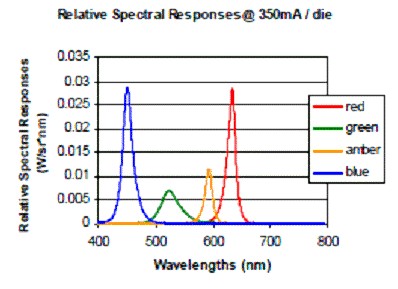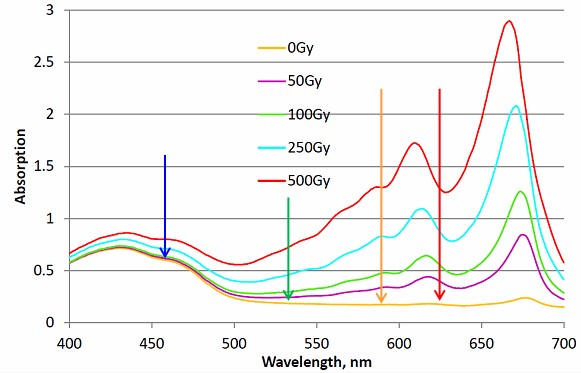Frequently Asked Questions (FAQ)
1. What are the advantages of the DoseReader4 to the flat bed scanner?
· Very high resolution. The resolution of the measurement of light intensity in theDoseReader4 (DR4) is equivalent to 18 bit ADC.
· No optical calibration is needed.
· High stability.
· Simplicity (no moving parts) and robustness
2. What are the advantages of the DoseReader4 to the spectrophotometer?
· High stability.
· Simplicity (no moving parts) and robustness
3. How can we introduce dosimeter identification?
Barcode identification system can be added to the DoseReader4.
4. How is the DoseReader4 shipped
The DoseReader4 is shipped in a hard shell plastic container with the following accessories:
a. Mains USB power supply 5V/1A
b. USB cable
c. CD content: Manuals, Drivers, Wedge programmes
d. 3 pc ND 1.00 Filter
e. 2 pc ND 0.50 Filter
f. Tweezers
5. How many wavelengths are available for the measurement of the optical density?
The optical density measurement is carried out at four different wavelengths (456, 532, 590, 625 nm) or optionally 560 nm wavelength is also available.
6. What is the light source of theDoseReader4?
A four colour light source is built in the DR4 densitometer with the following spectral data:


7. How does the DR4 measure the OD at the peak of the absorption spectra?
The DR4 measures the optical densities not at a certain wavelength (at the “peak” of the spectra of the dosimeter) but in region around the peak. This is certainly no disadvantage.
8. What is the lifetime of the light source
The lifetime of our light source is practically unlimited; it is stable mechanically and optically as well.
9. Which type of dosimeter can be used with the DR4?
After switching on, the DR4 can be configured for different dosimeters on the market as: Gafchromic® HD or MD or ETB3 dosimeter for different doses; GEX B3; or FWT-60 dosimeters. If the user knows the dose range and the type of the dosimeter, the DR4 can be configured before shipment.
10. How can very different doses be measured with one type of dosimeter film?
The user can measure the OD at certain wavelengths according to the absorption spectra response of the dosimeter film and the dose range. E.g. the HD-V2 film is more sensitive to the dose at red-amber colour than at blue colour, therefore we use 590 nm for lower doses and 458 nm for higher doses. This feature is the benefit of the multicolour light source used.

Gafchromic ® HD-V2 spectral response
11. What is the method to decrease the effect of the tolerance of the emulsion layer’s thickness?
E.g. the Gafchromic HD-V2 film incorporates a yellow dye in the active layer.
The gross response consists of two components:
· Background response due to yellow dye (and other minor contributing factors) – dependant on active layer thickness
· Response due to irradiation (gross response – background = net response)
By measuring the OD in the blue part of the spectrum the thickness of the active layer can be estimated and used to correct the OD reading at the longer wavelength. The corrected OD is simply OD590/OD458. This reduces the coefficient of variationfrom about 3% to less than 1%.
12. What QA can be carried out?
For the regular QA, the use of a ND (Neutral Density) film set is recommended. Five Kodak Wratten 2 Neutral Density Filters are included with the instrument; two pieces of OD0.5 (optical density=0.5) and three pieces of OD1.0 (optical density=1.0).
Combining the attached ND filters, the full OD range of the reader can be covered.
13. What is the QA of the dosimetry system?
A dosimetry system consists of dosimeters and the measuring instrument (optical density), such as spectrophotometer or our DoseReader4.
The calibration of the dosimerty system means that the dosimeter AND the measuring instrument are calibrated together. In the calibration process dosimeters should be irradiated in a certified irradiation facility and their calibration curve should be measured by the DR4.
If the dosimetry system is calibrated, it does include the nonlinearity of the DR4 as well. Therefore only the stability of the DR4 is important! The user should control the stability of the DR4 time to time at the wavelengths used.
14. How stable is the DoseReader4?
The latest electronics and optical components are used in the light source, in the light detector and in the data acquisition part of the DoseReader4, therefore our densitometer is very stable mechanically, contains no moving parts, its manipulation and maintenance are simple, it can be used also on the field as well.
15. Does the operation need special knowledge or training?
The DR4 pre-defines the measurement wavelength so operation is simply connecting it to a computer, inserting the dosimeter into the slot and pressing one button (or just closing the cover lid), there is very little scope for errors and the measurement can be taken by essentially anyone.
16. Is the DoseReader4 programmable?
The DoseReader4 is built around an embedded microcontroller board. This gives DR4 great flexibility and enables us to tailor the features of the device to the customer's needs. For example now DR4 calculates the "raw" OD value, displays it and transfers it to a connected computer.
If the customer specifies an algorithm to correct the "raw" OD value according to the specialties of the film used by an end-user this algorithm can be added to the basic software of DR4 and the device will display the correct OD value, no additional calculations are needed.
17. Can the DoseReader4 be used without computer?
Yes, if the DoseReader is not connected to a PC (in autonomous mode) the results or the instructions to the user are shown on a two line LCD display.
18. What is the warranty period?
The usual minimum warranty period is twelve (12) months after delivery or eighteen (18) months after shipment.
19. How can the user obtain the software needed to transfer measurement results from the R4 to a PC computer?
Two freely usable wedge programs and a proprietary one (RGwedge) are included in the shipped package. The attached user’s manual contains the handling instructions for RGwedge.